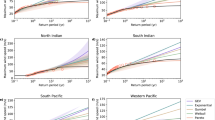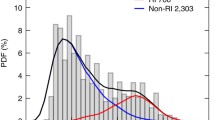Summary
Forecasts of tropical cyclone track and intensity have long been used to characterize the evolution and expected threat from a tropical storm. However, in recent years, recognition of the contributions of subtropical cyclogenesis to tropical storm formation and the process of extratropical transition to latter stages of the once-tropical storm’s lifecycle have raised awareness about the importance of storm structure. Indeed, the structure of a cyclone determines the distribution and intensity of the significant weather associated with that storm.
In this study, storm structure is characterized in terms of significant wind radii. The radii of tropical storm, damaging, and hurricane-force winds, as well as the radius of maximum winds are all analyzed. These wind radii are objectively derived from the H*Wind surface wind analysis system. Initially, six years of these data are examined for consistency with previous studies. Having ascertained that the H*Wind radii are realistic, detailed comparisons are performed between the H*Wind and NHC Best Track wind radii for two years (2004 and 2005) of North Atlantic tropical storm and hurricane cases. This intercomparison reveals an unexpected bias: the H*Wind radii are consistently larger than the NHC Best Track for all but the smallest and least intense storms.
Further examination of the objectively-determined H*Wind tropical storm force wind radius data compared to subjectively-determined radii for the same storm times demonstrates that the objective wind radii are underestimating the extent of the tropical storm force wind area. Since the objective H*Wind radii are large compared to the NHC Best Track – and yet underestimate the area of tropical storm force winds – this argues for further examination of the methods used to ascertain these significant wind radii.
Similar content being viewed by others
References
SB Cocks WM Gray (2002) ArticleTitleVariability of the outer wind profiles for western North Pacific typhoons: classifications and techniques for analysis and forecasting Mon Wea Rev 130 1989–2005 Occurrence Handle10.1175/1520-0493(2002)130<1989:VOTOWP>2.0.CO;2
M Croxford GM Barnes (2002) ArticleTitleInner core strength of Atlantic tropical cyclones Mon Wea Rev 130 127–139 Occurrence Handle10.1175/1520-0493(2002)130<0127:ICSOAT>2.0.CO;2
JL Demuth M DeMaria JA Knaff TH Von der Harr (2004) ArticleTitleEvaluation of advanced microwave sounding unit tropical-cyclone intensity and size estimation algorithms J Appl Meteor 43 282–296 Occurrence Handle10.1175/1520-0450(2004)043<0282:EOAMSU>2.0.CO;2
Ho FP, Su JC, Hanevich KL, Smith RJ, Richards FP (1987) hurricane climatology for the Atlantic and Gulf Coasts of the United States. NOAA Technical Report NWS. 38, U.S. Department of Commerce, 195 pp
SK Kimball MS Mulekar (2004) ArticleTitleA 15-year climatology of North Atlantic tropical cyclones: Part I. Size parameters J Climate 17 3555–3575 Occurrence Handle10.1175/1520-0442(2004)017<3555:AYCONA>2.0.CO;2
MA Lander (1994) ArticleTitleDescription of a monsoon gyre and its effects on the tropical cyclones in the western North Pacific Wea Forecast 9 640–654 Occurrence Handle10.1175/1520-0434(1994)009<0640:DOAMGA>2.0.CO;2
F Marks L Shay (1998) ArticleTitleLandfalling tropical cyclones: Forecast problems and associated research opportunities Bull Amer Meteor Soc 79 305–323
KV Ooyama (1987) ArticleTitleScale-controlled objective analysis Mon Wea Rev 115 2479–2506 Occurrence Handle10.1175/1520-0493(1987)115<2479:SCOA>2.0.CO;2
Pennington J, DeMaria M, Williams K (2000) Development of a 10-year Atlantic basin tropical cyclone wind structure climatology [Available online at http://www.bbsr.edu/rpi/research/demaria/demaria4.html]
R Pielke SuffixJr C Landsea (1998) ArticleTitleNormalized hurricane damages in the United States: 1925–95 Wea Forecast 13 621–631 Occurrence Handle10.1175/1520-0434(1998)013<0621:NHDITU>2.0.CO;2
MD Powell SH Houston (1996) ArticleTitleHurricane Andrew’s landfall in South Florida. Part II: Surface wind fields and potential real-time applications Wea Forecast 11 329–349 Occurrence Handle10.1175/1520-0434(1996)011<0329:HALISF>2.0.CO;2
MD Powell SH Houston LR Amat N Morisseau-Leroy (1998) ArticleTitleThe HRD real-time surface wind analysis system J Wind Eng Indust Aerodyn 77–78 53–64 Occurrence Handle10.1016/S0167-6105(98)00131-7
Schwerdt RW, Ho FP, Watkins RR (1979) Meteorological criteria for standard project hurricane and probable maximum hurricane windfields, Gulf and east coasts of the United States. NOAA Technical Report NWS 23, U.S. Department of Commerce, 317 pp
EW Uhlhorn PG Black (2003) ArticleTitleVerification of remotely sensed sea-surface winds in hurricanes J Atmos Ocean Tech 20 99–116 Occurrence Handle10.1175/1520-0426(2003)020<0099:VORSSS>2.0.CO;2
CL Weatherford WM Gray (1988a) ArticleTitleTyphoon structure as revealed by aircraft reconnaissance. Part I: Data analysis and climatology Mon Wea Rev 116 1032–1043 Occurrence Handle10.1175/1520-0493(1988)116<1032:TSARBA>2.0.CO;2
CL Weatherford WM Gray (1988b) ArticleTitleTyphoon structure as revealed by aircraft reconnaissance. Part II: Structural variability Mon Wea Rev 116 1044–1055 Occurrence Handle10.1175/1520-0493(1988)116<1044:TSARBA>2.0.CO;2
S Zielinski (2006) ArticleTitleNASA budget focuses on exploration EOS 87 98
Author information
Authors and Affiliations
Rights and permissions
About this article
Cite this article
Moyer, A., Evans, J. & Powell, M. Comparison of observed gale radius statistics. Meteorol. Atmos. Phys. 97, 41–55 (2007). https://doi.org/10.1007/s00703-006-0243-2
Received:
Accepted:
Published:
Issue Date:
DOI: https://doi.org/10.1007/s00703-006-0243-2




